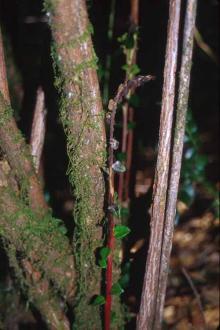See:
Tanoak (Notholithocarpus densiflorus) - Sudden Oak Death
Rhododendron - Ramorum Leaf Blight and Shoot Dieback
Cause The fungus-like organism Phytophthora ramorum, was found on a few dead and infected wild evergreen huckleberries and rhododendrons, as well as tanoaks (Notholithocarpus densiflorus) in a small area of Curry County in southwest Oregon. There were also incidental leaf infection on salmonberry, cascara, myrtlewood, and poison oak (stem cankers). Since the initial discovery, Oregon has focused on limiting the spread of the disease in Curry County through early detection, monitoring, and eradication of symptomatic tanoak trees. Despite these efforts, the quarantine area in Curry County has expanded many times since 2001 from 9 square miles to almost 50% of Curry County. The rate of disease spread increased most dramatically in 2014 requiring the quarantine area to nearly double in 2015. In 2015 a new outbreak was detected in the Cape Sebastien area. More recently, a new outbreak in the Port Orford area was found in 2021 on tanoak trees several miles outside the quarantine zone. Follow up surveys found over 100 infected trees and resulted in the treatment of 580 acres of forest land. This was considered a new introduction from the original outbreak and a new 3 square mile emergency quarantine zone was established.
The host list for this organism includes many different plants including tanoak which is very susceptible. Tip dieback and/or leaf spotting occurs on bigleaf maple, camellia, cascara, coast redwood, Douglas-fir, honeysuckle, horsechestnut, huckleberry, kinnikinnick, myrtlewood, Pacific madrone, pieris, poison-oak (stem cankers), rhododendron cultivars, salmonberry, viburnum and others (Note: those in bold are found infected in the nursery most often). Oregon white oak (Q. garryanna) does not appear to be very susceptible when challenged with the pathogen in lab tests. Federal and international quarantines have been established to prevent the spread of this pathogen in soil and infected plant material.
If you suspect you have seen a P. ramorum-infected plant in Oregon, call the Invasive Species Hotline, 1-866-INVADER (1-866-468-2337).
Symptoms The disease on evergreen huckleberry (Vaccinium ovatum) is characterized by darkened leaves and stems or defoliated stems. Infected leaves develop darkened leaf spots, usually starting at the leaf tip or along the leaf margin. Infected leaves typically abscise very quickly, making this symptom somewhat ephemeral. In severe cases, the entire aboveground portion of an infected huckleberry plant may be killed. Symptoms on red huckleberry (V. parvifolium) were similar where infected foliage was light tan to reddish brown in color, and a shoot dieback was also observed.
Cultural control Control efforts in Oregon are focused on containing the pathogen where it is found in forests and preventing new infections beyond the current quarantine area. Within the quarantine area, the quarantine requirements vary depending upon your location. For the most current quarantine requirements, please contact the Oregon Department of Agriculture.
- Do not transport firewood, other susceptible plant material, or soil from diseased areas in California or southwest Oregon.
- Wash shoes, vehicles, bikes, etc. if you visit infested areas of California or southwest Oregon.
- Contact the Oregon Department of Agriculture if you see or suspect trees or plants in Oregon with symptoms of this disease.
- In Oregon, Notify the ODA's Nursery and Christmas Tree Program when importing nursery stock from any out-of-state source.
- Purchase nursery plants only from nurseries certified as free from P. ramorum according to federal regulatory standards. A certified nursery will have an official certification shield.
Reference Goheen, E.M., Hansen., E.M., Kanaskie, A., and McWilliams, M.G. 2002. Sudden oak death caused by Phytophthora ramorum in Oregon. Plant Disease 86:441.
Elliott, M., Rollins, L., Bourret, T., Hulbert, J. M. and Chastagner, G. 2021. Three new hosts for Phytophthora ramorum confirmed in Washington State: Salal, Oregon grape, and red huckleberry. Plant Health Progress, https://doi.org/10.1094/PHP-01-21-0003-FI.


